Oh boy. If you have visited any on-line ASL community, there is little doubt you have seen question after question regarding prisoners. It is possibly the single-most confusing section of the rules. Questions such as:
- How do you capture prisoners?
- How do they surrender?
- When may I transfer them?
- How do I deal with them?
- Can they escape?
- Are Unarmed Units and prisoners different?
The list goes on for quite some length. To cover these topics, and more, I am going to use a lot more space than I normally do. I hope to make this article exhaustive. If there is a missing topic in this article please leave a comment or contact me so I may add it. I am hopeful by the end of this article you won’t reflexively choose to invoke No Quarter rather than deal with prisoners. Let’s get started.
Prisoners and Unarmed Units: What’s the Difference?
Per the Index, an Unarmed Unit is any unit without Fire Power (FP) usable on the IFT. Non-heroic leaders are armed but have no normal range on the IFT. A white (1)-0-6 counter represents an Unarmed MMC. Prisoners are an Unarmed Unit. Not all Unarmed Units are prisoners.
Captured Unarmed Units currently possessed by an enemy unit are prisoners. Any unit possessing prisoners is a Guard. Any armed Personnel unit may act as a Guard, even a broken one (A20.5). Unarmed Units in CC/Melee with their Guard are still prisoners.
Characteristics of Unarmed Units and Prisoners
| Unarmed Units | Prisoners |
|---|---|
| Don’t break, CR instead (A20.54) | Don’t break, CR instead (A20.54); leaders wound on a failed MC! |
| May pin | Don’t pin, share the pin status of their Guard (A20.54) |
| Eligible Sniper Targets | Not eligible Sniper Targets (A14.22) |
| DRs can activate a Sniper (SAN) | DRs cannot activate a Sniper (A14.1) |
| Controlled by their original side (A20.5) | Controlled by the capturing side (A20.53) |
| Eligible for K/# and KIA Random Selection (A7.3) | Eligible for K/# and KIA Random Selection (A20.54) |
| Have no CCV, may not attack an AFV in CC1 | Have no CCV, may not attack and AFV in CC2 |
| Can be charged by berserkers (A15.43) | Can’t be charged by berserkers (A20.4) |
| Are worth no CVP at game end (normal CVP if eliminated) (A20.55) | Are worth double CVP at game end (A20.1), double CVP immediately if eliminated by friendlies (A26.222) |
| Are Good Order (A.7) | Share the status of their Guard (CX, TI, etc) (A20.5, A20.51) |
| Are Inexperienced (A20.53) even if stacked with a leader (A19.3) | CC attacks against their Guard do not affect them (A20.54) |
| May possess and fire SWs (don’t forget A19.3) | Are unaffected by LLTC/LLMC (A20.54) |
| Do not affect enemy routs unless possessing a SW (A10.51, A20.5) | Captured SMC retain their normal morale; can apply leadership benefits to friendly units (i.e. other prisoners) |
| May not enter Location with a Known Enemy Unit (KEU) [EXC: Unarmed Japanese units; G1.15] (A20.5) | |
| Are not an obstacle to movement [EXC: Unarmed Japanese units; G1.15] (A20.54) |
Prisoners that escape without rearming, or which are Abandoned, are Unarmed Units. Control over these units reverts to their original side. Any Infantry/Cavalry can recapture Unarmed Units by entering an Unarmed Unit’s Location in the MPh and conducting an immediate CC attack (A20.54). Both sides are in Melee if the capture fails. Note the Unarmed Unit cannot attack back during this capture attempt. The attacker is eligible for leader creation but neither side can Infiltrate on a 2 or 12.28 Also note, elimination of Abandoned units in any subsequent Melee would invoke No Quarter (NQ) and Massacre penalties (A20.3, A20.4). You need to keep a careful record of Abandoned units since Escaped units will not invoke NQ/Massacre penalties.3
Example 1
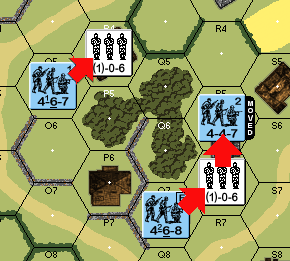
The 4-6-7 is executing its MPh. It elects to enter the Unarmed Unit’s Location and attempt to recapture. To do so, it enters for 2 MF and conducts an immediate CC attack against the Unarmed Unit. The attack would be 4:1. As this is a capture attempt and the Unarmed Unit suffers Inexperienced penalties, there is a -1 DRM to the attempt. Both units are in Melee if the capture fails. The Unarmed Unit cannot attack back and neither side is eligible for Infiltration. The 4-6-7 is eligible for Leader Creation.
The 4-4-7 Abandons its prisoner in the RPh intending for the 4-6-8 to recapture them in the MPh. After the 4-4-7 moves out, the 4-6-8 subsequently enters the Location and makes an immediate CC attack. Once again, the Unarmed Unit cannot attack back and neither side is eligible for Infiltration. The 4-6-8 is eligible for Leader Creation. If the 4-6-8 fails to capture both units are immediately locked in Melee. No Quarter and Massacre penalties apply if the 4-6-8 subsequently eliminates/Casualty Reduces (CR) the Abandoned prisoner. The 4-6-8 can try capturing again in the CCPh to avoid these penalties. Jumping ahead a bit, it is important to note these are Abandoned units and the 4-6-8 is NOT a Guard in this case. As such, attacks during the CCPh are not sequential. We will talk about this more but for now, just keep it in mind.
Interdiction
Interdiction (A10.53) plays a big role in surrender. Before we go any further we must first understand Interdiction. A unit which routs through an Open Ground hex (A10.531) without Low Crawl faces possible Interdiction. An Open Ground hex is any hex in which an enemy unit could hypothetically apply a -1 FFMO DRM. A unit routing through such a Location is at risk of surrender.
Routing through Open Ground on its own is not enough to cause Interdiction. One or more enemy units must also be capable of firing on that Location. The enemy unit must have LOS, be unbroken, within normal range, and able to apply at least one firepower on the Open Ground Location. Things without a printed range can be no more than 16 hexes away.

The Interdictor (A10.53) must also be free of positive DRMs. A BU AFV could not use any armament affected by a +1 BU DRM. Likewise, it could not Interdict if it must change TCA/VCA to do so. A Gun which needs to change CA cannot Interdict. Neither can a CX or Encircled unit. A unit in Melee cannot Interdict. A unit cannot Interdict if its firepower is halved for any reason (Pinned, Motion, long range, etc). While not specifically mentioned in A10.53, any unit affected by Target Selection Limits may not Interdict.4
Many enemy units may be capable of Interdicting an Open Ground hex, even one which has otherwise exhausted its fire options. A single unit may also Interdict many Locations if otherwise eligible. Interdiction is not an option. The opponent MUST Interdict if possible unless Concealed/HIP. 5 The opponent has the option to decide which unit will Interdict. 6 This rarely matters, but may in some specific cases. For instance, if the only possible Interdictor is a Gun having Acquisition on a different target, the Gun would lose Acquisition when forced to Interdict (C6.5). Being able to select some other unit to Interdict would allow the Gun to maintain its Acquisition. This can be used to your advantage. An AFV has your kill stack doubly acquired? Have a look around and see if you can voluntary break something and force him to Interdict the rout, removing the acquisition.
Effects of Interdiction

An Interdicted unit must immediately take a Normal Morale Check (NMC) and everything that normally entails, including Heat of Battle (HOB). A unit is Interdicted only once per hex. If it fails its NMC, the unit is CR. A leader voluntarily routing is immediately eliminated if the MMC it is routing with fails its NMC. This loss can cause a LLMC to the routing units. Note, the leader is only eliminated if the unit stacked immediately under it fails its NMC when routing as a stack (A10.711).
Any remaining units continue to rout, if able, after failing its NMC. A routing unit remains broken in its current Location if it pins. A broken unit is eliminated for failure to rout if pinned ADJACENT to an unbroken, armed, Known Enemy Unit (KEU). Note, a broken leader pins if it survives a Wound Check die roll (dr) and has spent over 3 MFs routing.
All of the following examples I do not show some counters for sake of clarity, especially DM counters.
Example 2

Assume NQ is in effect. The unit in EE8 must rout. Its legal rout destination is the woods hex in GG7 and it must rout through the Open Ground Location in FF7. So which units may Interdict it? The woods in EE8 block squad A’s LOS to FF7. Squad B has a +1 grain hindrance in FF8 negating FFMO. Squad C has target selection limits. Squad D is CX and has a positive +1 DRM making it ineligible for Interdiction. Squad E’s LOS passes through the wreck in EE6 adding a +1 hindrance DRM negating FFMO. However, squad F has a clear, unobstructed LOS into FF7 and Interdicts the routing unit.
The routing unit must take an NMC in that Location. If it fails the NMC it is CR to a HS and continues its rout to GG7. A Final DR 7 on the NMC pins the MMC in FF7. On a (1,1), make a subsequent HOB DR. The HOB DR could battle harden (and rally) the unit. It may also generate a hero, disrupt the unit, or some other result. Sometimes, more than one of these results might apply.
Assume the wreck is not there. In that case, squad E could also Interdict. Here, even though more than one unit can Interdict, the broken unit would only make one NMC in FF7.
Example 3
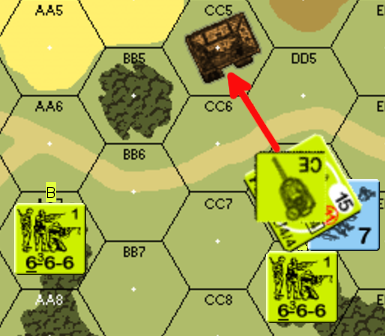
Again, NQ is in effect. The broken German unit must rout and its legal destination is CC5. It must go through DD5. Note the Sherman is CE allowing its MA to Interdict. Even if the Sherman was BU, its CMG could Interdict as its TCA covers DD5 and a BU DRM does not apply to the CMG. Squad B can also Interdict. The German unit must take a NMC in DD5. A Final 7 on the NMC pins the unit in DD5. This eliminates the unit for ending its rout ADJACENT to a unbroken, known, armed enemy unit. The remaining unit would continue its rout to CC5 on any other non-HOB result, even CR unless, it rolled a 12, which would eliminate the squad.
Example 4

Again, NQ is in effect. The broken units must rout to DD7/DD8 via CC8. The German player voluntarily routs the 9-2. Per A10.5, units rout one at a time. A10.711 allows a leader to voluntarily rout along with a single broken unit. The leader does not take a NMC himself and can use his leadership to affect the DR. However, the leader must be careful which unit he attempts to rout with.
Imagine the German player rolls a 10 on the Interdiction NMC. If the leader routs with the broken 4-6-7 it is immediately eliminated for being stacked directly over a unit failing its NMC. The remaining HS also takes a LLMC with a +2 DRM (2MC). Had the leader instead routed with the 8 morale unit, the unit would have pinned and the leader would survive, remaining in CC7 with the broken 4-6-8. Even when routing, it is important to pay attention to the composition of your stacks.
Also note, A10.711 says “he is eliminated if the broken unit he is stacked on top of fails an Interdiction MC”. I believe it is the intent of this rule that the leader MUST stack on top of the broken unit. I don’t believe any rule compels this stacking though. It would take a ruling from Perry (and probably errata) to clarify this belief.
Taking Prisoners
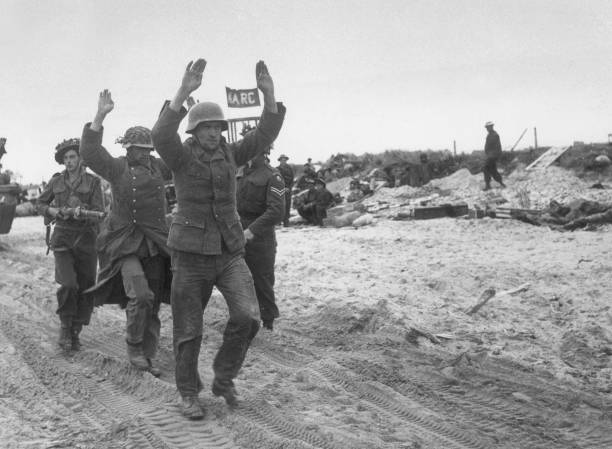
Nearly four full pages in and we can finally talk about actually taking prisoners. I know it seems like a lot, but the previous sections will provide a foundation for understanding what follows. You can capture prisoners in three ways:
1) Rout Phase Method
By far, the most common way to take prisoners is via the Rout Phase method (A20.21). A broken unit ADJACENT to an armed, Good Order, Known enemy Infantry/Cavalry unit unable to rout away without Interdiction will surrender to that ADJACENT unit. If Low Crawl is the only way to avoid Interdiction it will still surrender. A unit may not voluntarily break if the break eliminates it for failure to rout or forces the unit to surrender.8
Surrendering units drop all possessed Support Weapons and Guns before surrendering to their captor. If there is more than one unit surrendering in the same Location, the captor must accept or reject those units as a stack (A20.21). A surrendering leader does not cause a LLMC/LLTC. A leader eliminated when invoking NQ can cause a LLMC in the Location it originally occupied.9
Example 5
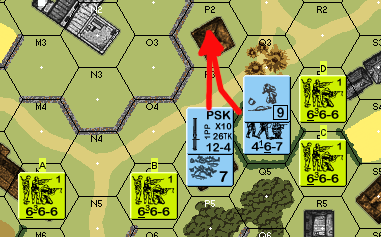
It is RtPh and the German units must rout. Each unit must rout to P2 via P3. Unfortunately for the German player, squad A and B can Interdict P3. Each German unit must surrender to an ADJACENT unit. The 4-6-7 drops its panzerschreck in P4 first and then surrenders to squad B where a full squad (1)-0-6 white counter replaces the German unit.
The broken 9-2 surrenders to squad C or D. Should one elect to take the prisoner, remove the 9-2 from the board and keep a side record of the SMC prisoner. Alternatively, you could use a third-party SMC prisoner counter if you have them. No LLMC/LLTC is caused in Q4 when this happens. Should the American player instead opt for NQ when the 9-2 surrenders, the 9-2 is eliminated in hex Q4 causing a 2MC on the 4-6-7 as a LLMC. Should the 4-6-7 fail the LLMC, it too must then rout away.
The Unbroken 4-6-7 would like to rout as well, sensing the unfavorable Close Combat coming. Unfortunately, it cannot. Voluntary breaking here would compel the 4-6-7 to join the 9-2 in surrendering and a unit may not voluntary break if doing so causes its elimination or surrender.

Berserk units, Berserk unit, units in Melee, Unarmed Units 10 , and vehicles cannot take prisoners. A broken unit will rout normally, taking Interdiction as needed, if it cannot surrender. Eliminate for Failure to Rout any unit which cannot surrender and is otherwise unable to rout. Units eliminated in this manner do not invoke NQ or Massacre effects (A20.21, A20.4).
ADJACENT Disrupted/Encircled units, or units surrendering because of HOB, will rout to their captor even if they have an otherwise legal rout path free of Interdiction. Keep in mind, the whole rout path must be free from Interdiction to avoid surrender.11
Example 6
26 April 2022 Update: I have received a response to a Q&A concerning this example. At issue is the meaning of the Q&A cited in footnote 11. In that Q&A, it mentions “whole rout path” without clarifying what that means. Perry has clarified his initial response to be “the whole CURRENT rout path”.29
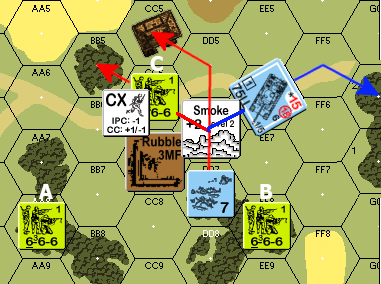
It is the RtPh in the German Player Turn. The broken German unit must rout. BB5 or CC5 is the rout destination. Each Location is 5 MFs away and the 4-6-7 must choose between them. Since squad C is out of LOS, the red arrows represent viable rout paths free from Interdiction. The astute will notice squad A can interdict CC6 and may believe BB5 is not a valid destination. This is incorrect. Because the rout to DD5 is free from Interdiction the broken squad has a rout path free from Interdiction and as such, will not Surrender. Because BB5/CC5 are equidistant, the broken unit could opt to risk Interdiction in CC6 to reach BB5.
The broken squad enters DD6 and now has LOS to squad C. Its “CURRENT” rout path to BB5/CC6 is no longer valid and it must select a new “CURRENT” rout path, but now with 4 MFs remaining. Given the remaining MFs, it could chose either GG6 or GG7. The broken unit cannot ignore GG6 and routs there, represented by the blue arrow. The only allowable path must pass through FF5/FF6, which are Interdicted by squad B. As the “CURRENT” rout path is not Interdiction-free AND the broken unit is again ADJACENT to a Known enemy unit (squad C), the German unit Surrenders to squad C.
Had the German player recognized his dilemma in the MPh, he could have Stopped the Panther in EE7 instead of EE6. With the Panther in EE7, the rout path to GG6/GG7 is free from Interdiction since the Stopped Panther provides a +1 Hinderance DRM after the AFPh. The broken German squad would safely rout to GG6/GG6 although it would have to rout through EE6 and FF6 to avoid Interdiction in FF5.

A Disrupted unit (A19.12) surrenders during the RtPh to an ADJACENT, Good Order, armed12 known enemy Infantry/Cavalry unit not in Melee. Armed enemy units may freely enter a Disrupted unit’s Location. If a Good Order, Known enemy Infantry/Cavalry unit enters its Location, a Disrupted unit surrenders immediately regardless of phase (A19.12). Some units will never Disrupt. Disrupted units subject to NQ will not surrender and will rout away even if an enemy unit is in their Location. Normal rout rules apply [EXC: A Disrupted unit may never use Low Crawl, except at Night].13
Some units will never surrender via the Rout Phase method (A20.21). Partisans (including Communist Guerillas, W6.5), Gurkhas, Commissars, SS troops facing Russians, Fanatic units, Japanese, Turkish units (W5.11) and units faced with NQ will not surrender. Units such as these will Low Crawl or face Interdiction. Eliminate any unit otherwise unable to rout for Failure to Rout.
Example 7
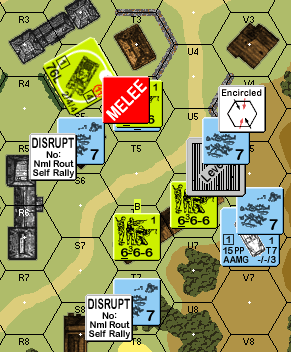
It is the RtPh. The broken German unit in U6, level 1, surrenders as it is Encircled and ADJACENT to a known, armed enemy unit.
The Disrupted unit in T7 must surrender to squad B even though it has a legal rout path to S8.
The Disrupted unit in S5 would normally surrender but it cannot surrender to a vehicle or units in Melee. It routs normally to R5 and may continue its rout as long as it observes all the normal rout rules. If there were an American unit in R6, the Disrupted unit is instead eliminated for failure to rout.
The broken squad in the ht is not required to rout, even though ADJACENT to known, armed enemy unit.
Let’s look at the routs if the American has invoked NQ. The unit in T7 now routs to S8 rather than surrender.The Encircled unit must rout to Level 1 in T6, but once there it will be eliminated for failure to rout. The unit in S5 routs as it did before. The broken unit in the ht is still not compelled to rout. It remains broken in the ht.
Heat of Battle
HOB surrender is a sub-case of the Rout Phase method in many ways. It is helpful to think of it that way. A unit which rolls a Final HOB DR >= 12 becomes broken and Disrupted and surrenders immediately to any ADJACENT known, armed 14 enemy Infantry/Cavalry unit. There are some exceptions to this. Non-elite Italians and Axis Minors surrender on a Final HOB DR >= 10. Units which won’t surrender via the Rout Phase method will go Berserk instead. There are other fine details here so I encourage you to look at A15.5 if your Final HOB DR is >= 12. For those playing scenarios set in Korea please also review W3.11, W5.11, and W7.9.
Example 8
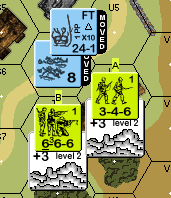
It is the American Defensive Fire Phase. The 8-3-8 was previously broken as it entered T5. As he can rout away, the American opts to take his 16+3 resulting in a MC. The German player rolls a 1,1 for an HOB result which he then follows up with a 6,6 on the A15.1 Heat of Battle Table. As his unit is broken (+1) and Elite (-1), the final result is ≥ 12 and his 8-3-8 will surrender immediately to one of the ADJACENT American units, American player’s choice.
But wait! The American player declared NQ. Looking at the asterisk next to the 12 result, we treat surrender results as a berserk result instead. Flipping his counter over and marking him with a berserk counter, the German player waits for the AFPh for some payback. Continuing his wild swings, the German player rolls a 1,1 with the flamethrower attack against the HS, for a final K/4 result since he does not cower. This eliminates HS A. The 8-3-8 would like to advance into CC but per A15.431 a berserk unit can’t move in the APh so it ends its turn in T5.
2) Close Combat Phase Method
A non-vehicular, non-Berserk unit in Close Combat (CC)/Melee may opt to designate its CC attack as an attempt to take prisoners (A20.22) when attacking Personnel units. A capture attempt adds a +1 DRM unless targeting Inexperienced Personnel. A -1 DRM applies if the target is Inexperienced. Inexperienced units not stacked with a leader are very susceptible to capture using this method. Capture may occur even after declaration of NQ.15 Even more odd, capture is possible through a Hand-to-Hand attack.16
Capture occurs if the capturing unit’s Final CC DR is < the CC Kill# on the A11.11 Close Combat Table. If a unit’s Final CC DR equals the CC Kill# one defending unit of the defender’s choice is captured. If the captured unit is a full squad, a half squad (HS) is captured and the remaining HS is uncaptured. Replace captured units with Unarmed Units of the appropriate unit size.
Example 9
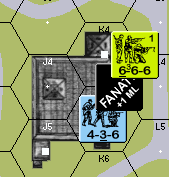
NQ is in effect for both sides. The American advances into CC and will attempt capture. Normally Fanatic units will not surrender via the Rout Phase method but they can be captured in CC. The attack for the Americans will be 3:2, the Germans attack back at 1:2. Looking at the A11.11 Close Combat Table, the Kill# for the American is 6. The German will need a 4. Additionally, the Americans will receive a -1 DRM for attempting to capture an Inexperienced unit. If the American rolls a 7, his Final DR will be 6 and captures one HS and leaves a German HS in the Location. Replace the German unit with a HS and give the American unit an HS prisoner. If the American rolls a 5 or less, he captures the whole squad. Remove the German squad and give the American units a full squad prisoner.
Next, the German attacks back. If he rolls a 4, he will CR the American squad who would still control any prisoners taken. If the German rolls a 3, the American squad is eliminated and it is treated as if the attack never happened. This would leave the original German unit in the Location.
The Americans may attack via Hand-to-Hand per SSR. While it seems counter intuitive, capture can occur via H-t-H. Now the American Kill# is an 8 while the German is a 6. Other than the new Kill#s, everything else remains the same. If the American rolls a 9, its Final DR is a CR, capturing a HS and leaving a HS in the Location, and if he rolls an 8 or less, he captures the whole squad.
The German attacks back per above, but now if he rolls a 6, the American squad is CR, leaving it in control of any prisoners taken. A DR of a 5 or less eliminates the American unit and the original German unit remains in the Location.
In either case, if enemy units from both sides remain in the Location, Melee is formed. In case it isn’t clear, attempting to capture without an ambush is fraught with peril unless you bring multiple units to the party.
All of this seems fairly straightforward, but you have to keep in mind attacks to capture are usually simultaneous with other CC/Melee attacks. It is possible for one side to “capture” the other, only to be eliminated by the very unit it captured. Even more interesting, it is possible for one side to capture the other while simultaneously being captured itself.
How do we deal with all of this? Per A20.221, if the side being captured eliminates its captors, it remains unchanged as if the capture attack was ineffectual. If both sides eliminate/capture the other, things get more interesting. First, remove eliminated units. Each remaining unit drops any SW they possess. Then, replace each unit with an Unarmed Unit of the appropriate size. Next, replace each Unarmed Unit with with a Conscript/Green unit of the correct unit size (A20.551). If newly rearmed units from both sides remain in the same Location, they are in Melee and covered with a Melee counter. Making a capture attempt during simultaneous CC is fraught with risks. Proceed accordingly!
Example 10
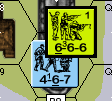
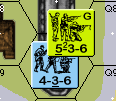
The American is attacking and declares an H-t-H capture attempt. Subsequently, the German player decides he will attempt to capture back. Both sides roll a 3 and capture each other. As such, each side is replaced with an Unarmed Unit which immediately rearms. As a result, the American unit will be replaced with a Green 5-4-6 while the German unit will be replaced with a Conscript 4-3-6 (A20.211). As units from both sides remain in the same Location at the end of the CCPh, the Location is covered with a Melee counter. In later rounds, one or both sides may continue capture attempts until no enemy units remain in the Location. Figure 10b shows the remaining counters without the covering Melee counter.
Oddities Capturing Japanese/CPVA Units
Step-Reduced Japanese/CPVA MMC can be captured in CC. You capture and replace the full squad normally. If you only capture a HS by a Final CC DR equal to the Kill#, the captor takes a HS prisoner and an uncaptured HS would remain in the original Location.17 In essence, treat the “striped” squad as unstriped before dividing into two HS.
Japanese units may also attempt Hara-Kiri to avoid capture in CC (G1.641). If successful, eliminate the Japanese unit and award the appropriate Victory Points (VP) to his opponent. If the Japanese unit fails to commit Hara-Kiri it may not attack in CC and an additional -1 DRM applies to the capture attempt. To commit Hara-Kiri, the Japanese units involved must first pass a Normal Task Check (NTC) with no leadership modifiers. A Berserk/heroic unit need not pass an NTC, it automatically eliminate itself. I encourage you to read G1.641 for all the modifiers if you’re contemplating this for your units.
Example 11
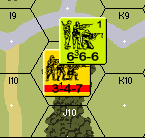
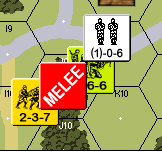
The American enters into CC and will attempt capture. Attacking at 2:1, the American Kill# is a 7. The American rolls a Final 7. The Japanese player completely whiffs his attack. The Japanese squad is replaced with a HS. A second prisoner HS counter is given to the American. As there are units from both sides remaining in the Location, a Melee counter is placed. Figure 11b shows the situation at the end of the initial CC attack.
As the American unit possess a Prisoner unit (i.e., it is now a Guard), the follow-on CC/Melee attacks will be sequential (A11.33). What’s more, the prisoners are now free to attack in CC and in the Japanese Player Turn it becomes H-t-H. The Japanese HS and the prisoner HS will combine to attack with 3 firepower. The American’s options are not stellar. He can ignore the non-Prisoner and attack just his Prisoner at 6:1. He could attack non-Prisoner HS with half FP (3:2), or he could opt to attack both with half firepower (1:1). In any case, he will defend with his full 6 firepower and need not declare his attack until after the Japanese have made their attack. As the attacks are sequential, the Japanese player will attack first, and only a surviving American unit may attack back. From here, attacks are resolved in the normal manner, each side having all of its normal CC options.
The Japanese player could have opted to attempt Hara-Kiri rather than risk the capture. To do so, it must first pass a NTC. If it passes this check, the Japanese unit is eliminated immediately. If it fails, the Japanese unit could not opt to attack the American unit in the same CCPh. Additionally, the Americans receive a -1 DRM to their capture attempt.
3) Mopping Up
This is by far the easiest to explain. A broken unit in a building which is successfully Mopped Up (A12.153) immediately surrenders to a unit of the ATTACKER’s choice inside that building regardless of proximity. Mopping Up will work even if no stairwell remains. You can even capture units which won’t surrender via the Rout Phase method.18 The broken units will not surrender if any concealed units remain in the Mopped Up building. Even if Mopping Up doesn’t work, Disrupted/Encircled and ADJACENT units will still surrender in RtPh via the Rout Phase method if eligible.
Example 12
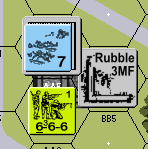
It is the American PFPh. The BB4 building is a Multi-Story building with the stairwell in BB4. No other stairwell exists in the building. The American player states he will Mop Up the building. Even though there is no available stairwell in the building, the broken unit immediately surrenders. Any American unit in the building (even if not Mopping Up) can take the German unit as a prisoner. Remove the German squad and give a full squad prisoner to the American unit.
If there is a hidden unit in the same building, it is placed on the board concealed and the broken unit would not surrender.
Handling POWs
Once captured, place prisoners above their Guard. The Guard possesses them as if a support weapon. A Guard may only be relieved of this duty in the APh or RPh by transferring prisoners to another unit or Abandoning them in the APh as if they were a SW. A Guard may guard a total Unit Size (US#) of prisoners up to five times its own US# (A20.51). An SMC could guard a squad and HS (total US# of 5) but not three HS (total US# of 6). A Guard can automatically exchange two prisoner HS for a full squad and vice versa. Thus, a SMC being transferred three HS to guard could exchange two HS for a full squad and not exceed its capacity to guard.
A unit guarding prisoners suffers some drawbacks. A Guard’s FP is halved when attacking non-prisoners.19 A Guard still defends with full FP. If a Guard is guarding greater than its own US# in prisoners it may not attack any unit other than its prisoners, except in CC. It may not use a SW, Interdict, or Kindle.
Both crews and half squads are represented using an Unarmed HS. Make a record of crews on a side record for VP purposes. Given a crew is worth two CVP, whereas a HS is worth one, this record keeping is important for maintaining a proper VP count. Also note any SMC on a side record. This SMC retains its normal morale and leadership levels (A20.5). It is also important to note a SMC has a US# of one and does count against the limit a Guard can guard.20 If you have third-party (TPP) SMC prisoner counters this is easy to track. If you record it on a side record you have to pay particular attention to your notes. Personally, when I play I take the SMC and flip it to its broken side. The Guard can possess this broken unit just like any other Unarmed Unit. It is easy enough to remember and I have a visual clue I can refer to keeping me honest.
Example 13

All buildings are ground level only. It is the RtPh and the German player must rout his broken units. Since there are no legal rout paths, the German units will all surrender to an ADJACENT unit. The American player takes these units with the hero.
Recall from earlier, a Guard can only guard up to 5 times his own US# and the German units surrendering amount to a US# of 6. The American player could opt to let one HS go free as an Unarmed Unit but that unit could rearm (see below) and come back to haunt him. Fortunately, he has another option.

As already noted, a Guard may freely exchange a full Unarmed squad for two Unarmed HS and vice versa. As such, the American replaces two HS with a full squad. Also note, the crew is represented as an Unarmed HS. Record this on a side note for VP purposes.
At the end of the RtPh, the situation looks like figure 13b.
As noted earlier, a unit can voluntarily transfer or Abandon prisoners only in the RPh or APh. This transfer is like any other transfer except such a transfer does not penalize either unit’s capabilities for that phase. As such, a Guard could transfer a prisoner AND attempt a SW repair in Rally Phase for example.21
Example 14
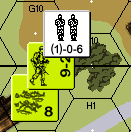
It is the RPh. The 9-2 first attempts to rally the squad in G0. The squad rolls an 8 and successfully rallies. Normally, that would be the complete RPh for each of these units. However, recall that transferring prisoners can be done in the RPh and does not penalize either unit’s capabilities for that phase. Recognizing there are far more important things for his 9-2 to be doing, the American player could also transfer the prisoner to another squad were one in the same Location.
Abandoned prisoners revert to the control of their original owner as Unarmed Units. Immediately rearm Abandoned SMC by placing the appropriate SMC counter.22
Elimination of the Guarding unit can involuntarily force a prisoner transfer. Any unit friendly to the captor and capable of accepting their transfer immediately assumes the Guard position regardless of Phase (A20.5).27 Assumption of this duty is not voluntary.23 If no units capable of accepting transfer and friendly to the captor are present the prisoners are freed. A Guard eliminated in the same Location as the now freed prisoners may rearm some in accordance with A20.551.
Example 15
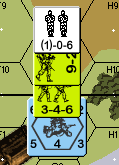
The German Sniper activates with a 2 and has found the 9-2’s Location. Recall, prisoners are not eligible for Random Selection. As with all 9-2s, the Random Selection naturally chooses the 9-2. The American rolls a 5 on his Wound Severity dr, eliminating the 9-2. The HS must immediately become a Guard of the prisoners and still has a 2MC coming. Even if the HS was broken, it would still have to assume Guard duty if the 9-2 is eliminated. Assumption of Guard duty is not an option. If the HS was e.g., broken or pinned, it would not be capable of accepting the transfer of the prisoners. In this case the prisoners would be freed and considered to have escaped.
Making Prisoners Work for You
Some things you can do with prisoners:
- You can make prisoners attempt entrenchment, clear rubble, clear a roadblock, or clear a Flame. Guards forcing labor share the same TI/Movement status as the prisoners do, including Hazardous movement if applicable. Keep in mind that any nationality bonus for Entrenching is NA to prisoners (A25.21, W7.92)
- An unbroken Guard squad can deploy into two HS automatically, regardless of leader or nationality requirements/restrictions. You may also deploy a full prisoner squad into two HS. This is a powerful tool for units not normally able to deploy. They can “pass around” the prisoners and deploy at any time. Imagine a squad which deploys itself and its prisoner squad. These HS transfer their prisoners in Advance Phase to two new squads. Each of these deploy and can pass along the HS prisoner to other units down the line to deploy, perhaps in the next Rally Phase.
- Japanese, Partisan, Russian, SS, KPA (W6.3), and Berserk Infantry/Cavalry may Massacre (A20.4) Prisoners in their Location if not in Melee. Such elimination counts as use of a SW and automatically eliminates its declared prisoner target. Keep in mind limits on SW usage.24 A Berserk unit in the same Location as prisoners, whether Guarding them or not, MUST Massacre them. Massacring prisoners returns the Berserker to normal. If not in the same Location as prisoners, Berserk units will ignore prisoners for purposes of determining where to charge (A15.432). Committing a Massacre immediately raises the enemy ELR by 1 and invokes NQ (A20.4).
- Prisoners are worth twice their Casualty Victory Points (CVP) at game end if still possessed by the capturing side. Unarmed Units are no longer captured. They are worth normal CVP if eliminated during play. Of special note, prisoners eliminated by an attack from a friendly side are still worth double CVP to the captor. Guards may also escort prisoners off a Friendly Board Edge (A20.53) without awarding CVP to the enemy for leaving the board. Prisoners escorted off the board still count double for CVP purposes at game end. A20.3 and A20.4 applies to Abandoned prisoner units. If the capturing side later eliminates these Unarmed Units, it invokes Massacre and NQ penalties.25 Keep careful track of units Abandoned for VC purposes.
- If Interrogation (E2) is in play, prisoners are great sources of information. When captured, prisoners are subject to immediate Interrogation. On a Final Interrogation DR <= 5 some information about its original side is compromised. When playing in Korea, some specific rules cover Interrogation as well. See W6.1 and W7.9 for details.
Perhaps the War ISN’T Over for You
If a stack of units surrenders and is larger than the available Guard capacity, the captor determines which excess units to free/Abandon as Unarmed Units. Eliminating their Guard frees prisoners if there is no other enemy in the Location able to guard them. Some units freed in this manner may rearm under A20.551. Otherwise units are freed as Unarmed Units and revert to their original side’s control in either instance.
The methods above don’t require work on the prisoners’ part. To earn it, prisoners engage in CC with their Guard. A prisoner may attack its broken Guard in CC. In order to attack in CC, the prisoner must first pass a Normal Task Check (NTC). If they pass the NTC they attack their Guard in CC. They can attack other units in the Location as part of a combined attack including the Guard. If they eliminate their Guard, they escape and may rearm up to the Unit Size of their Guard. Prisoners may Infiltrate (A11.22) to escape CC/Melee. Prisoners will not accompany their Guard if it Infiltrates during a Melee. 26 A Melee forms if the Guard survives. Once Melee forms, any prisoner may attack its Guard (even if unbroken) without passing a NTC. Once a Melee forms, prisoners may opt to Withdraw from Melee. Successful Withdrawal leaves an escaped Unarmed Unit. Unless someone comes to help, their fate is sealed. Eventually, the Prisoners will withdraw or win the CC as the broken Guard cannot attack back.
Example 16
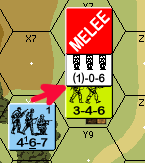
The 4-6-7 advances into the existing Melee. As there are prisoners in Melee the German units will attack first. The German prisoner elects to Withdraw. The American player will attack the prisoner in hopes of stopping the Withdrawal. If the prisoner succeeds in Withdrawing it will become an ESCAPED Unarmed Unit. Control over this unit revert to the German player.
Should the German player roll a 12 on his CC attack, the Guard could opt to Infiltrate from Melee but in doing so, it would leave the prisoner behind as an Unarmed Unit, control reverting to the German player. Note, the Unarmed Unit left behind has escaped, not been Abandoned. Abandonment can only take place in the RPh or APh. Should the American roll a 12, the prisoner and the German unit could Infiltrate to an Accessible Location with the Unarmed Unit once again under German control.
As highlighted in example 11, prisoner CC attacks are sequential with the prisoners attacking first. If prisoners stack with other friendly units, the combined attack goes first but MUST include the Guard as a target. Prisoners eliminated while escaping do not incur NQ or Massacre penalties. Prisoners eliminated in this manner still count for CVP purposes but are not worth double.
The Not So Gentle Art of Rearming
Escaped SMC are always Armed. Just place the SMC on the mapboard in the proper Location and you’re done.
Whenever a prisoner is in a Location where an enemy unit is eliminated or captured in CC, it may immediately rearm. Provided there are no other armed enemy units currently in the Location, a prisoner may rearm if its Guard is otherwise eliminated. When this happens, rearm Unarmed Units up to the Unit Size of the eliminated units. If a HS is eliminated where a full squad Unarmed Unit is located, replace the Unarmed Unit with a Conscript/Green HS and an Unarmed HS (A20.551). For those playing scenarios set in Korea, W2.21, W4.2, and W5.1 also cover specific cases for rearming.
Example 17
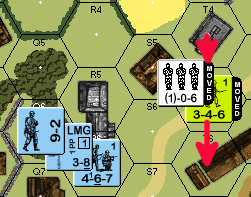
The American unit elects to Dash to T6 with its prisoner. The German player attacks the move in T5 with a 2 -4 attack. The final result is a 1KIA. The Random Selection to determine which unit suffers the KIA includes both the American unit and its prisoner. Unfortunately for the American, the Guard is selected and eliminated.
A KIA would normally break the prisoner too, but as noted earlier, prisoners do not break, they CR instead. This reduces the Unarmed Unit to a HS. It also awards two CVP to the Americans as friendly fire eliminated a HS.
Now, there is an unguarded, Unarmed HS in a Location where an enemy HS was just eliminated. Immediately replace the Unarmed HS with a Conscript German HS.
Example 18
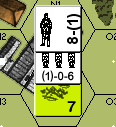
First note we are using a VASL counter to represent a captured 8-1 leader. Unless you have a third-party counter in your own set, you would be using a side note. Other than the VASL-specific counter, everything else would be the same at the table.
It is the CCPh. The American 3-4-6 HS Guard is broken. As such, the prisoners may attempt an NTC to try and escape. If they pass, they may attack their captors in CC. Per A20.5, a captured leader maintains normal morale and leadership. As such, he can affect friendly units, including the NTC here. The leader cannot affect his own NTC. Assume both prisoners pass their NTC and can CC its Guard. The attack against the Guard would be 1:2. There is a -1 DRM for leadership and a -2 DRM for attacking broken units. A Final DR of 4 or less will eliminate the HS Guard, meaning an Original DR of 7 or less eliminates the Guard. A broken Guard may not attack back. If the Guard survives, a Melee forms and the prisoners may continue to attack their Guard until they eliminate it, either side Withdraws, the game ends, etc.
If the prisoners eliminate the Guard, they have escaped. Immediately rearm the leader and place its original counter in the Location. A HS equivalent will rearm to Conscript HS. In the end, the Location will contain a Conscript HS, an Unarmed HS, and the 8-1 leader.
Unarmed Units may Scrounge (A20.552) to rearm. Scrounging wrecks (D10.5) offers a better chance of success. Successful Scrounging replaces the Unarmed Unit with a Green/Conscript of equal size (squad/half squad). Again, for those playing scenarios set in Korea, W2.21, W4.2, and W5.1 cover specific cases for rearming.
Generally, prisoners/Unarmed Units lose all previous armed identity. Crews are no longer crews, fanatic units are no longer fanatic. Sappers are no longer sappers. They lose all of their previous conditions and capabilities. If they rearm they all become Conscript/Green units of the side they are rearming to. This does mean weapons Inherent to that side will rearm as well. For instance, a captured German crew becomes an Unarmed HS. Should it break free and rearm, it would become a Conscript German HS and could try for panzerfausts and ATMMs if the year allows it. Units rearming to something other than a Conscripts/Green unit retain all the capabilities of the units restored to (W2.21, W4.2, and W5.1).
Example 19
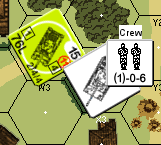
The Unarmed Unit in X2 was originally a German crew and previously Abandoned by its captor. During the RPh it may attempt to Scrounge the destroyed Panther in its Location in an attempt to rearm. On a dr of 1-3, a unit Scrounges enough small arms to rearm up to a HS-sized unit. Assume a 2 is rolled.
Recall that when captured, the Unarmed Unit loses all of its previous identity. It is replaced with a Conscript HS when rearming. As this is a German unit, this means it has all the inherent capabilities of a German Conscript HS. This includes panzerfausts and ATMM if the scenario date allows it.
Conclusion
Here at the end, I will offer up a couple rules of thumb. Keep in mind, every rule was made to be broken and these are no exception.
- If the VC requires building control, invoking NQ is likely not the best option.
- Once NQ is in effect you can no longer Mop Up making building control a little harder.
- Clearing broken units from upper floors will take more effort.
- Taking prisoners can enable you to deploy units contrary to your national capabilities.
- Consider taking prisoners if the VC awards double CVP for taking them.
- Manipulating your opponent into killing his own guys is an easy way to instantly gain CVP.
- Interrogating prisoners is definitely worth your time if allowed by SSR.
- If prisoners are not worth double, or the VC does not incentivize you to take prisoners, then invoking NQ is not likely to hurt you too much.
- It will allow broken enemy units more freedom to rout however, so keep that in mind.
For those of you who have made it this far, I applaud your stamina. I hope you paced yourself, this article covered a lot of ground. It took me some 40 – 50 hours writing it so I feel the pain of your journey. I also know that even as I release this for publication, it is not complete. I imagine there is also some lurking error in here. This is where you come in.
If you think something is missing, please reach out to me so I can add it. Please let me know if you spot a mistake so I can fix it. I will take feedback on missing examples or missing Q&A as well. It is my hope this article will continue to grow and evolve over time and maybe someday serve as a basis for updating the A20 Prisoner rules.
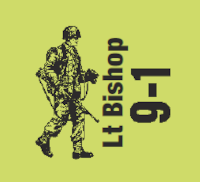
As always, I hope you find this article useful. It is my hope that after reading this you won’t reflexively say “No Quarter” just so you don’t have to wade through this section of the rules. If even one of you pauses for a moment to consider the implications of doing so, I will consider this article a success. Until next time. — jim
Version 3.3
The Germans had taken a Russian 426 prisoner, and eventually they ended up with their guards in the same hex as a German StuG that was bogged & UK. The guards broke and were eliminated for failure to rout. Due to the StuG the former prisoners cannot be re-armed (A20.551). Subsequently, a Russian 328/10-0 jump into CC to finish off the StuG, but fail. Can the former prisoner attack the AFV in CC as well?
A. No; unarmed units do not have a CCV.
Are escaped Prisoners which do not rearm ALSO subject to the Protection of A20.3 - 20.4?
A: No.
Can a unit with a CC counter interdict? More specifically, can a unit with an enemy BU AFV in motion in their hex interdict?
A. The CC counter is immaterial, but target selection limits would prevent a unit with an armed Known enemy unit in its Location from Interdicting.
If the ATTACKER routs a broken unit without using Low Crawl, through an Open Ground hex that is in the LOS and Normal Range of a an unbroken enemy unit capable of fire on it in that hex with at least one FP without any form of LOS Hindrance, can the DEFENDER decline Interdiction and allow the broken unit to disregard a NMC?
A. Only if concealed.
If the ATTACKER routs a broken unit without using Low Crawl, through an Open Ground hex that is in the LOS and Normal Range of multiple unbroken enemy units capable of firing on it in that hex with at least one FP without any form of LOS Hindrance, can the DEFENDER choose which of the qualifying Interdictors enforces the Interdiction (e.g. so that an otherwise qualified Interdictor can maintain Target Acquisition as per C6.5)?
A. Yes.
May a unit voluntarily break if it will result in their immediate surrender via A20.21?
A. No, since that could result in their immediate elimination.
An enemy squad of lower morale than its accompanying Leader are in a Location ADJACENT to a Good Order known friendly infantry unit. The enemy Leader is broken and must Surrender to the ADJACENT Good Order known friendly unit which does now declare No Quarter. Is the broken enemy Leader a) eliminated in its current Location—thus causing a LLMC on the accompanying enemy squad or b) eliminated in the Location of the friendly unit that declared No Quarter?
A. a).
Unarmed Units are Good order but not armed. A19.12 does not say the unit needs to be armed, only Good Order. Do disrupted units Surrender to ADJACENT, known, Unarmed Units?
A. No (see also A20.21); look for errata to both A19.12 and A15.5 to add "armed".
When determining whether a broken unit would surrender to an ADJACENT unit, is the entire rout path examined for Interdiction or simply the first hex away from the enemy unit to which it is ADJACENT? That is, the first hex may be non-Open Ground but the second or third hex on the path to the target woods/building is Open Ground and therefore the unit would be Interdicted at that point during the rout.
A. The entire rout path.
If a unit is disrupted and No Quarter is in effect, what happens to the disrupted unit if an enemy unit moves into its location during the MPh? Is it immediately eliminated? (It would surrender immediately in NQ were not in effect.)
A. No.
If not eliminated, what mechanics are used for routing away during the opponent’s MPh?
A. It does not rout away during the opponent’s MPh. It routs away as normal during its RtPh (or is eliminated for failure to rout if unable to rout) - just as if an enemy unit had entered the Location of a non-Disrupted broken unit (Berserk, HW/Banzai). {2}
May this (capture during the CCPh) be attempted by a side which earlier invoked No Quarter?
A. Yes. {4}
An allied unit rolls to capture a Japanese striped squad, but only captures a half squad (i.e., final roll = the CC kill#). Is the result
1) a captured halfsquad and an uncaptured halfsquad (i.e. the stripe disappears),
2) A captured halfsquad only, or
3) an uncaptured halfsquad only?
A. 1) a captured halfsquad and an uncaptured halfsquad
When a building that is being Mopped-Up only contains enemy broken units which cannot surrender as per A20.21 (i.e., SS vs. Russian), do they still surrender when Mopped-Up? What if they’re in an upper-level location?
A. They Surrender (the Surrender limitation is only on RtPh Surrender.). Doesn’t matter. {1}
Imagine 4-6-7 Guard with a full squad prisoner and an enemy 4-4-7 in melee. Can the 4-6-7 attack them both or is it limited to only attacking the prisoner? If it can attack both, does it attack 2:5 (half FP) or at 4:5?
A. It can attack both, but its FP is halved then since it is attacking non-prisoners.
says to record a captured SMC on a side note. Does the SMC still count against the 5 times Unit Size limit for a Guard?
A. Yes
Does this mean a unit could transfer a prisoner AND do other RPh/APh activities (transfer a weapon, rally a unit, deploy, repair a unit, etc) at the same time effectively giving them two actions?
A. Yes
This rule says “Escaped SMC are always Armed.” Are Abandoned SMC prisoners also always Armed?
A. Yes. {2}
A location contains a squad, and a broken HS that is Guarding a squad of Prisoners. In the CCPh, the prisoners pass a NTC and attack their Guard in sequential CC. The Guard HS is eliminated, so the Prisoner squad is replaced by a Conscript HS (through rearming) and an Unarmed HS. Since the Guard was eliminated, MUST the squad assume Guard duties for the unarmed HS that remains, prior to making its own CC attack? (A20.5 says “may immediately assume the Guard position”, not “must immediately assume the Guard position”.
A. The squad has to become a Guard, since the Prisoners did not successfully Escape per A20.55.
Can a Guard/Berserker eliminate only 1 prisoner counter in an A20.4 situation? Does each prisoner eliminated count as a SW use? Or can ≤ all prisoners be eliminated at the “cost” of a single SW use?
A. It can eliminate as many prisoner counters as it wants for its SW usage. {2}
A Good Order German squad holds a squad’s worth of Russian prisoners. Another Russian unit enters CC with them, with no result either way; resulting in a Melee. The next turn the prisoners attack their guard first (no NTC or broken guard required in Melee). The prisoner rolls a 6,6 against the GO guard, resulting in Infiltration for the guard. If the guard elects to withdraw on the 6,6, do his prisoners accompany him?
A. No, the prisoners cannot accompany the Guard withdrawing from Melee.
A20.5 ... Should the Guard unit be eliminated, any unit capable of accepting their transfer (disregarding phase) must assume the Guard position....
Existing Q&A says this:
A20.5 & A20.55 A location contains a squad, and a broken HS that is Guarding a squad of Prisoners. In the CCPh, the prisoners pass a NTC and attack their Guard in sequential CC. The Guard HS is eliminated, so the Prisoner squad is replaced by a Conscript HS (through rearming) and an Unarmed HS. Since the Guard was eliminated, MUST the squad assume Guard duties for the unarmed HS that remains, prior to making its own CC attack? (A20.5 says “may immediately assume the Guard position”, not “must immediately assume the Guard position”. A. The squad has to become a Guard, since the Prisoners did not successfully Escape per A20.55.
The Q&A implies must where the rules say "may". Is it a must? If it is a must, would a broken unit HAVE to assume Guard duties if no other unit was available? If the answer is "may", would an Unarmed unit rearm if the enemy opted not to assume Guard duties? Does this change if the only available Guard is broken? If it does rearm would this form immediate melee or would the Location just be marked with a CC counter? A A20,5 should probably say "must immediately assume".
Per 20.55, Escape is successful only if there are no enemy units CAPABLE OF ACCEPTING TRANSFER WHEN A GUARD IS ELIMINATED PER 20.5 in the same Location. [WORDS IN CAPS IMPLIED]
Broken units are not "capable". If there is a Melee, everyone would be in Melee.
A. No.
Is Infiltration possible?
A. No.
What about leader creation?
A. Yes.
A. The entire rout path.
Q: What does "entire rout path" refer to in the Q&A above?
A. The entire current rout path.


Jim,
Maybe I missed it in your thorough analysis but one thing that I think is important is that an escaped prisoner(unarmed unit) if it possess a LMG it becomes armed and can be used to gain control of a victory location? Can it then also prevent enemy MMC units from entering it’s location during the movement phase unless Beserk/HW?
Stan
Hey Stan,
Obviously, leaders just become their normal selves. Lets set them aside.
In the table at the top of the article, left hand column there are two entries:
— May possess and fire SWs (don’t forget A19.3)
— Do not affect enemy routs unless possessing a SW (A10.51, A20.5)
From the Index:
Armed (any Personnel unit is Armed unless currently represented by an Unarmed counter (A20.54) not possessing a functioning Gun/SW, as is any non-Abandoned vehicle with an Inherent Crew)
So at the point they possess some SW, they become Armed, even though they may not have any Inherent Small Arms (still a (1)-0-6 counter). They are inherently GO so they become like any other Inexperience, Good Order MMC. In that case, they can capture VC Locations if otherwise able to and would stop enemy personnel units from entering their Location with some exceptions (banzai, berserk, cavalry charge, passengers, etc). — jim
Question: In example 18, is the 1 to 2 attack coming from 2 x prisoner(1) vs broken HS strength (3)?
It was a mistake. The attack should be 1:4. Thanks for catching this! — jim
Example 2:
It may also generate a hero, disrupted the unit, or some other result.
should read:
It may also generate a hero, disrupt the unit, or some other result.
Example 4:
A10.5 rout one at a time, exc. A10.711. A10.711 speaks in the singular.
Don’t see a Q&A that allows a stack to rout other than a non-pinned GO leader with a single broken unit.
There is an outstanding Q&A I am waiting on to resolve example 4. To be honest, I never even considered units didn’t rout as a stack since they surrender as a stack. I have played a lot of games and I cannot recall anyone routing singularly. This doesn’t make it right, it is just not something I EVER considered.
Also, the rest of A10.711 speaks to a leader “stacked on top of” which makes little sense if the routing stack has a singular routing unit. Furthermore, what if I just place the leader on the bottom? Am I compelled to place the leader on the top? I see nothing requiring it.
That’s a lot of words to say I am aware of the contradiction and I am working to resolve it. Thanks for the comments. — jim
I updated the article to reflect the new Q&A.
I think the “stacked on top of” is just a convention. You have to stack with the broken unit to rout with it, that’s about all that section means as unbroken units, typically don’t rout.
But the rule clearly says “… he is eliminated if the broken unit he is stacked on top of fails an Interdiction MC …” While I agree the intent is to place the leader on top, no rule in the ASLRB dictates how you stack. If someone puts their leaders on the bottom, they technically aren’t subject to elimination by the letter of the rule. Now I think common sense says this is not right, there isn’t any rule I am aware of I could point to and say “you’re wrong”.
So the rule needs errata? Seems that way.
At least a PerrySez
I believe it does. But, if you watched the Illuminating Rounds talk, you’ll see I mention A20 is in dire need of a rewrite and a comprehensive example.
Great article.
In EX6, if the routing unit were to enter DD6 and see squad C, would GG7 not be an ignorable alternate rout destination on the basis that it is no further away from squad B (two hexes in both cases at the point where the rout route is recalculated)? Would that not in turn mean that there are no non-ignorable rout destinations that the routing squad can reach in its RtPh and allow it to rout to either to DD6 or EE6 instead, neither of which are subject to interdiction?
First, I edited your post to change D6/E6 to DD6/EE6. I hope you’re OK with this. Doing so makes your question clearer and makes my response easier to understand.
WRT your question, the original rout to BB5/CC5 is not ignorable. That means DD5 isn’t really a destination, it’s a way point. Once it gets to DD5, it recalculates. It could choose to ignore GG7 as you suggest, but I believe the outcome would remain the same. The issue is the unit has no rout path from his ORIGINAL Location free from Interdiction without resorting to Low Crawl. Per A10.52 “… At the start of its RtPh, a routing unit must designate its destination and must attempt to reach it during that RtPh [EXC: if using Low Crawl] …” Both destinations you propose (DD7 –> DD6 and DD6 –> EE6) are both Low Crawls even if DD7 –> DD6 is somehow legal. As such, the routing unit is rewound back to its original Location and it surrenders Adjacent (20.21 RtPh: Any broken Infantry unit during its RtPh that is both ADJACENT to Known, Good Order, armed enemy Infantry/Cavalry and unable to rout away from it or only able to rout while being subject to Interdiction or resorting to Low Crawl … will surrender to that enemy unit as its prisoner instead …)
Part of the reason for this example is to show being rewound to the start and making it clear it is the whole rout-path that matters. Too many players will rout to the decision point, start over and say “I am free from Interdiction here so I don’t surrender to the original unit” and that is not the case. I refer you to footnote 11 for the relevant Q&A. Thanks for the question! — jim
You are absolutely right that the whole rout path has to be considered when determining whether a unit has to surrender. My thinking is that, leaving aside the surrender issue for the present, the routing unit would first of all head towards BB5/CC5. When it enters DD6, it sees the previously unknown unit in AA4 and has to reconfigure its route. The only other woods hex that it could legally reach is GG7 but I believe that is ignorable due to being no further away from the 666 in EE8 (A10.51):
“…A routing unit may also ignore a building/woods hex if that hex is no farther from a Known enemy unit than its starting hex, even if it must rout through that now-ignored hex to reach its destination.”
All of this assumes that “starting hex” refers to the hex from which the rout is re-calculated as opposed to the original starting hex (which might be debatable).
At this point, this part of A10.51 kicks in-
“If no non-ignorable building/woods Location can be reached during that RtPh, a broken unit may rout to any terrain hex consistent with the above restrictions and need not rout toward the nearest woods/building Location. ”
The routing unit therefore now has two options: it can remain in the smoke hex in DD6 just as if this had been its original starting point or it can rout to the cover of the AFV in EE6. In both cases it would be routing to “any terrain hex” as opposed to carrying out a low crawl.
If we now re-wind to the start of the rout, we know in advance that the routing unit cannot reach any non-ignorable woods or building hex. It can therefore rout to any terrain hex consistent with the normal routing restrictions and chooses either DD6 or EE6. Since either can be reached without interdiction, it doesn’t have to surrender.
If there was a woods/building hex in GG6 instead of or in addition to GG7, it would be non-ignorable, DD6 and EE6 would no longer be legal destinations, and the broken unit would have to surrender just as stated in the example.
Just IMHO.
Anyway, this article is about prisoners as opposed to the somewhat arcane rules pertaining to rout paths and apologies for sidetracking it!
While I don’t agree with your conclusion, the example is easy enough to fix so I am going to. The image is already updated. I am about to work on the text too. Thanks for your feedback.
Changing the subject, I think that this section needs to be amended slightly:
“Whenever a prisoner is in a Location when an enemy unit is eliminated or captured in CC, it may rearm provided there are no other armed enemy units currently in their Location.”
My reading of A20.551 is that the presence of an enemy unit is only relevant if the guard is eliminated other than by way of CC. If the prisoner kills its guard, it is re-armed regardless of the presence of any other enemy unit.
“One attacking Unarmed friendly unit of equal or smaller size is rearmed immediately for each armed enemy unit it eliminated/captured in CC (or by any other means if no other enemy unit is currently in the same Location)…”
It could probably use a clarification.
Example 18 makes no sense.
No strength is shown on the broken unit and the leader gets to attack with the 1-0-6. Making 2fp unit. I don’t recall any 7ML broken American unit having 8 fp.
Something was deleted….
I clarified the Guard to be a 3-4-6. I also corrected the odds. I was persuaded I was doing it wrong earlier when I was actually doing it correctly.
You did make me re-visit the example and I have added an additional clarification to it.
Thanks for your questions. — jim
Jim – Really enjoying the articles. A quick question on Example 3: If the Sherman had an ACQ counter on either BB5 or CC5, and the US player opted to interdict with the CMG, I assume they would lose the ACQ (per the earlier discussion about the mandatory nature of Interdiction). For the US player, since he has a choice, the better option appears to be interdicting with Sqd B so as not to affect the Sherman’s status. If Sqd B was not there, then the US player would not have a choice and would have to interdict with the CMG, thus losing the ACQ counter. It’s probably not a situation that comes up that often, but I expect that players in the Interdictor’s position might reflexively use the CMG since it is closer (I don’t think there is a requirement to use the closest unit to interdict) without realizing the implications.
You are correct. There is no proximity requirement other than “normal range”.
Great article Jim.
If a captured SMC is wounded and possessed by a broken enemy unit (BEU) that must rout, can the BEU abandon the prisoner SMC to be able to rout using more than 3MF?
This situation arose in a game I played over the weekend. Fortunately, Low Crawl was an option and we just settled on that, assuming that a longer route would force abandonment and reappearance of the wounded SMC.
Prisoners move at the foot rate of their captors. — jim
A20.53: “All prisoners move at the foot rate (not the Cavalry rate) of their accompanying Guard as one combined stack….” So the wounded SMC’s 3 MF doesn’t matter….
Couple of old Q&A: A20.53 Do even wounded SMC prisoners move “at the foot rate … of their accompanying Guard”? Can wounded SMC prisoners be Portaged as per A17.2? Can Captured leaders increase their Guard’s available MF?
A. Yes. Yes. No. [Letter4]
A20.53 Does a wounded leader prisoner move at the foot rate of his guards, or just 3 MF?
A. The former. [Letter87]
Thanks Jim
You’re welcome.
A fantastic article Jim, this has opened my eyes on so many facets of rout and surrender.
I do have a quick question on example 6. Doesn’t the US squad in AA8 have a LOS to CC6? Given that the route is interdicted (if that LOS exists) and the unit is in LOS of the German broken unit wouldn’t the unit have to surrender if it selected either of the red paths that go through CC6? It doesn’t affect the core of the example, i.e., the unit surrenders mid rout anyway, but it could cause some questions. If there were smoke or grain in BB7 then this problem goes away?
Cheers Phil
WRT example 6, yes the squad in AA8 has an LOS to CC6, but the LOS to DD5 is blocked by by the Rubble. The rule says Surrender when NO path is available. In this example, there is one to BB5. The rule doesn’t say a unit MUST rout via this path if other options are available. As such, the red rout paths are valid since they are all equidistant, although as you correctly point out, the unit would be subject to Interdiction in CC6 if it routs through that Location. The rule in question:
A20.21 RtPh: Any broken Infantry unit during its RtPh that is both ADJACENT to Known, Good Order, armed enemy Infantry/Cavalry and unable to rout away from it or only able to rout while being subject to Interdiction or resorting to Low Crawl (regardless of how it actually routs or if the possible unconcealed Interdictor is Known to it), will surrender to that enemy unit as its prisoner instead, (captor’s choice of unit receiving surrender if more than one unit qualifies) after first abandoning all its SW [EXC: if pinned; 10.53 & G5.5].
Notice “regardless of how it actually routs”. If all the options are Interdicted, it would surrender. If one of the equally distant rout destination is Interdiction free, it is allowed to chose where it wants to rout and take Interdiction, if necessary, without needing to Surrender.
Hope this helps. — jim